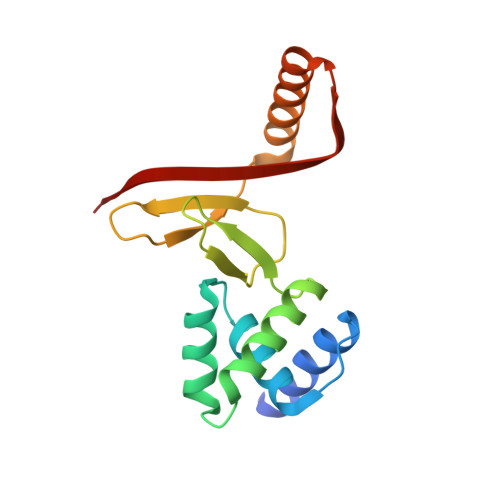Structure and function of the Leptospira interrogans peroxide stress regulator (PerR), an atypical PerR devoid of a structural metal-binding site.
Kebouchi, M., Saul, F., Taher, R., Landier, A., Beaudeau, B., Dubrac, S., Weber, P., Haouz, A., Picardeau, M., Benaroudj, N.(2018) J Biological Chem 293: 497-509
- PubMed: 29146596
- DOI: https://doi.org/10.1074/jbc.M117.804443
- Primary Citation of Related Structures:
5NL9 - PubMed Abstract:
Peroxide sensing is essential for bacterial survival during aerobic metabolism and host infection. Peroxide stress regulators (PerRs) are homodimeric transcriptional repressors with each monomer typically containing both structural and regulatory metal-binding sites. PerR binding to gene promoters is controlled by the presence of iron in the regulatory site, and iron-catalyzed oxidation of PerR by H 2 O 2 leads to the dissociation of PerR from DNA. In addition to a regulatory metal, most PerRs require a structural metal for proper dimeric assembly. We present here a structural and functional characterization of the PerR from the pathogenic spirochete Leptospira interrogans , a rare example of PerR lacking a structural metal-binding site. In vivo studies showed that the leptospiral PerR belongs to the peroxide stimulon in pathogenic species and is involved in controlling resistance to peroxide. Moreover, a perR mutant had decreased fitness in other host-related stress conditions, including at 37 °C or in the presence of superoxide anion. In vitro , leptospiral PerR could bind to the perR promoter region in a metal-dependent manner. The crystal structure of the leptospiral PerR revealed an asymmetric homodimer, with one monomer displaying complete regulatory metal coordination in the characteristic caliper-like DNA-binding conformation and the second monomer exhibiting disrupted regulatory metal coordination in an open non-DNA-binding conformation. This structure showed that leptospiral PerR assembles into a dimer in which a metal-induced conformational switch can occur independently in the two monomers. Our study demonstrates that structural metal binding is not compulsory for PerR dimeric assembly and for regulating peroxide stress.
Organizational Affiliation:
From the Unité de Biologie des Spirochètes.





















